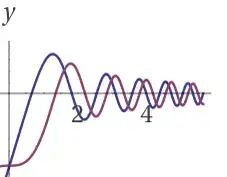This question will take inspiration from
Evaluation of $\sum\limits_{n=0}^\infty \left(\operatorname{Si}(n)-\frac{\pi}{2}\right)$?
and
On $\mathrm{\sum\limits_{x=1}^\infty Ci(x)}=\frac{\ln(2)+\ln(\pi)-γ}{2}$
The problem will include the version with the Fresnel integrals. The separate sums converge to a similar value each, but converge slowly due to oscillation. Note there are also hypergeometric function representations, but these probably are not useful for evaluation. F(x) is the Dawson Integral function. I will not put more representations as they can easily be found in the link. The other representations are just as complicated. Here are the definitions:
$$\mathrm{C(x)=\int cos\left(x^2\right)dx, S(x)=\int sin\left(x^2\right)dx, \lim_{x\to\infty} C(x), S(x)= \frac{\sqrt\pi}{2\sqrt2} }$$
so the function is asymptotic to $\frac{\sqrt\pi}{2\sqrt2}$ and the following follow from it:
$$\mathrm{\sum_{n=0}^\infty \left(C(n)-\frac{\sqrt\pi}{2\sqrt2}\right)+\sum_{n=0}^\infty \left(S(n)-\frac{\sqrt\pi}{2\sqrt2}\right)=-\sqrt{\frac\pi2}+\sum_{n=1}^\infty \left(C(n)+S(n)-\sqrt{\frac\pi 2}\right)=\sum_{n=0}^\infty \left( \frac{(1 - i) \left(F\left( (-1 + i) n\right) - i\,F\left((1 + i) n \right) e^{2 i π n^2 }\right)}{e^{in^2}}+ \frac{(1 - i) \left(F\left((-1 + i)n\right) - i\,F\left((1 + i) n\right) e^{i π n^2}\right)}{e^{ i n^2 }}-\sqrt{\frac\pi 2}\right)=log_b\prod_{n=0}^\infty b^{C(n)+S(n)-\sqrt{\frac\pi2}}}$$
Here is what each individual summand looks like using the problem’s definitions. The blue plot is the cosine version and the purple is the sine version:
There are also sum to integral representation formulas like the Abel-Plana formulas. This one may work with the Abel-Plana formula:
$$\mathrm{\sum_{n=0}^\infty \left(C(n)-\frac{\sqrt\pi}{2\sqrt2}\right)+\sum_{n=0}^\infty \left(S(n)-\frac{\sqrt\pi}{2\sqrt2}\right)=-\frac12 \frac{\sqrt\pi}{2\sqrt2} +\int_0^\infty C(x)-\frac{\sqrt\pi}{2\sqrt2}dx +i\int_0^\infty\frac{C(ix)-\frac{\sqrt\pi}{2\sqrt2}-C(-ix)- -\frac{\sqrt\pi}{2\sqrt2}}{e^{2\pi x}-1}-\frac{\sqrt\pi}{2\sqrt2} \frac12+\int_0^\infty S(x)-\frac{\sqrt\pi}{2\sqrt2} dx+ i\int_0^\infty\frac{S(ix)-\frac{\sqrt\pi}{2\sqrt2}-S(-ix)- -\frac{\sqrt\pi}{2\sqrt2}}{e^{2\pi x}-1}= 2\int_0^\infty \frac{S(x)}{e^{2\pi x}-1}dx-2\int_0^\infty\frac{C(x)}{e^{2\pi x}-1}dx-\frac12 -\frac{\sqrt{\pi}}{2\sqrt2}}$$
Another idea is to use the main power series definition of the Fresnel Integrals seen in the bolded link:
$$\mathrm{\sum\limits_{n=0}^\infty \left(C(n)-\frac{\sqrt\pi}{2\sqrt2}\right)+ \sum\limits_{n=0}^\infty \left(S(n)-\frac{\sqrt\pi}{2\sqrt2}\right)= \sum\limits_{x=0}^\infty \left(-\sqrt\frac{\pi}{2}+\sum_{n=0}^\infty\left(\frac{(-1)^n x^{4n+3}}{(2n+1)!(4n+3)}+\frac{(-1)^nx^{4n+1}}{(2n)! (4n+1)}\right)\right)}$$
Using this Imaginary Error function definition, one other idea is to notice that:
$$\mathrm{(-1)^{\frac74} \frac{\sqrt{\pi} }{2}\,erfi\left(\sqrt[4]{-1} x\right)=C(x)+i\,S(x)=\int e^{ix^2}dx\implies \sum\limits_{n=0}^\infty \left(C(n)-\frac{\sqrt\pi}{2\sqrt2}\right)+ \sum\limits_{n=0}^\infty \left(S(n)-\frac{\sqrt\pi}{2\sqrt2}\right)= Re\sum_{x=0}^\infty \left((-1)^{\frac74} \frac{\sqrt{\pi} }{2}\,erfi\left(\sqrt[4]{-1} x\right)-\frac{\sqrt\pi}{2\sqrt2}(1+i)\right)+Im \sum_{x=0}^\infty \left((-1)^{\frac74} \frac{\sqrt{\pi} }{2}\,erfi\left(\sqrt[4]{-1} x\right)-\frac{\sqrt\pi}{2\sqrt2}(1+i)\right)=}$$
This means that an equivalent summation to find is the following. Let’s try to use the Abel-Plana formula on it:
$$\mathrm{\sum_{x=0}^\infty \left((-1)^{\frac74} \frac{\sqrt{\pi} }{2}\,erfi\left(\sqrt[4]{-1} x\right)-\frac{\sqrt\pi}{2\sqrt2}(1+i)\right)= -\frac{\frac12\sqrt\pi}{2\sqrt 2}(1+i)+\int_0^\infty (-1)^{\frac74} \frac{\sqrt{\pi} }{2}\,erfi\left(\sqrt[4]{-1} x\right)-\frac{\sqrt\pi}{2\sqrt2}(1+i)dx +i\int_0^\infty \frac{(-1)^{\frac74} \frac{\sqrt{\pi} }{2}\,erfi\left(\sqrt[4]{-1} ix\right)-\frac{\sqrt\pi}{2\sqrt2}(1+i)-(-1)^{\frac74} \frac{\sqrt{\pi} }{2}\,erfi\left(\sqrt[4]{-1} -ix\right)+\frac{\sqrt\pi}{2\sqrt2}(1+i)}{e^{2\pi x}-1}dx= -\frac{\sqrt\pi}{4\sqrt 2}(1+i)+\frac i2 +(-1)^\frac34 \sqrt\pi\int_0^\infty\frac{erf\left(\sqrt[4]{-1}x\right)}{e^{2\pi x}-1}≈.65507…+.86175…i}$$
Note there may be a typo. How can I evaluate this integral or summation? Please correct me and give me feedback!
